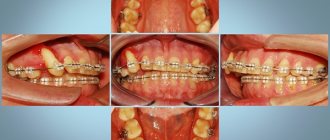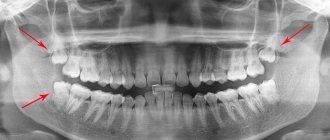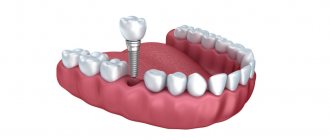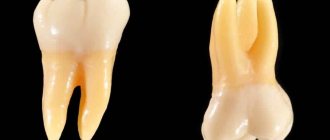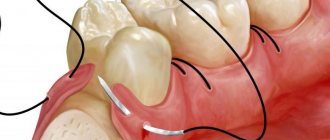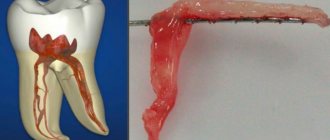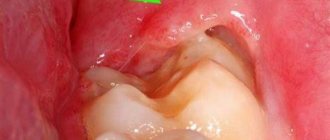From this article you will learn:
- how wisdom teeth are removed - photos and videos,
- how painful it is, what complications there are,
- price for wisdom tooth removal in Moscow.
The article was written by a dental surgeon with more than 19 years of experience.
Removing a wisdom tooth in dentistry - in half of the cases, is a complex surgical operation, which is associated with the difficulty of extracting the tooth from the dental alveoli (for example, due to severely curved roots or abnormal position in the jaw). Of all the human teeth, it is the eruption of wisdom teeth that causes patients the most discomfort, which usually happens when there is not enough space in the dentition for their eruption. And in this case, their removal also helps prevent crowding of the front teeth.
The times when dental surgeons hollowed out wisdom teeth using a surgical chisel and hammer are long gone. And even more so, none of the dentists use such a weak anesthetic as novocaine for pain relief. Currently, if a wisdom tooth is in such a position that it cannot be removed entirely from the jaw (without causing significant injury to the surrounding tissues), the doctor uses a special water-cooled drill. This allows you to separate the tooth into parts, quickly removing the roots individually.
Removal of the eighth tooth (wisdom tooth) –
The decision to remove already erupted wisdom teeth is made based on the possibility and necessity of using them for prosthetics in the future. It is very easy to remove a wisdom tooth, but effectively restoring the end defects of the dentition (if you do not have 6-7-8 teeth) can only be done with dental implantation. Therefore, sometimes even a severely damaged eighth tooth is worth restoring in order to later use it as a support for a bridge or to improve the fixation of removable dentures.
If we are talking about removing wisdom teeth that have not yet erupted (or partially erupted), then in adolescents it is optimal for the orthodontist to make the decision. The rudiments of the eighth teeth are formed in children aged 4-5 years, while the formation of the crown part ends at approximately 12 years, and the complete formation of roots - only at 24 years. If necessary, a teenager can have his unerupted eighth teeth removed, i.e. with not yet fully formed roots.
How is tooth extraction performed?
Removal of a impacted tooth.
Tooth extraction is carried out in several steps:
- First of all, the affected tooth, as well as tissues close to it, are treated with an antiseptic disinfectant.
- Anesthesia is performed.
- The doctor places the forceps on the root of the element and begins to loosen it. As a result of such manipulations, the hole enlarges and the tooth is separated from the ligament.
- Now you can rip it out. After removing the edges of the resulting hole, they cover it with cotton balls to compress them. The wound itself becomes filled with blood clots.
Tooth extraction is a quick operation, but sometimes difficulties arise, for example, the need to cut the tooth into elements and remove it in parts. This happens when the root system has a complex structure or the bone element has a non-standard shape.
Important! You should not eat food for the first two hours after surgery, and alcoholic beverages for the first two days. In addition, it is necessary to rinse the mouth during the day after tooth extraction: before bed and before meals.
If you follow the dentist’s recommendations, within two weeks the wound will heal and you can forget about the pain.
Why is wisdom tooth removal painful?
Painful sensations always arise for a reason, but due to the impact of some aspects.
What factors does it depend on?
The difficulty and pain of removal depends on the roots of the tooth.
How intense the pain is depends on the following factors:
- the mood of the patient himself . Local anesthesia helps to perform the operation without pain, but before going to the doctor, you need to calm down and have a positive attitude towards the problem;
- location of the affected element . Removing front teeth is sometimes not as painful as molars. This happens because the front ones are less firmly fixed in the jaw, and also because of their small size;
- the number of tooth roots - if there are many of them, the operation will be painful;
- patient sensitivity . Each person has their own limit for the perception of pain. Some patients feel absolutely nothing during tooth extraction, while others feel pain even after anesthesia.
Tooth extraction is a shock to the human body, like any other operation. Even people with a high pain threshold will not be able to tolerate painful sensations if the intervention is performed without anesthesia.
Today, tooth extraction is still not a particularly pleasant process, but there is no need to endure forced pain. The type and dose of the anesthetic drug is selected by the doctor individually for each patient.
Awareness/lack of awareness of the process
It is important to find out in a preliminary conversation what type a particular person belongs to. Some people feel calm, knowing in detail what will be done to them, while others are only more alarmed by the details, and they prefer to abstract themselves from the process as much as possible, believing in “magic,” if you will.
You can compare these reactions with the experiences of passengers during air travel. Some people feel calm until they know all the processes in aircraft systems. And others suffer from aerophobia, and they are helped by various information materials that cover the details of the work. At the same time, for the first category, such knowledge can be dangerous and destroy their peace of mind and faith in the divinity and reliability of air transportation.
Painful sensations
The degree of pain during the removal of different types of teeth.
| When removing anterior milk teeth | If the operation is performed in a dental clinic, doctors use general anesthesia. The child does not feel discomfort during the operation, but after the anesthesia wears off, an acute attack of pain may occur at night. In addition, body temperature can rise to 38.5 degrees and remain there for several days. |
| Chewable milk | The sensations when a chewing baby tooth is removed are not much different from those experienced by a child when his front tooth is removed. If discomfort persists after surgery, it can be eliminated with painkillers. |
| Molar anterior without anesthesia | Removing an anterior molar without anesthesia is accompanied by severe pain, so the operation can be performed in this way only in exceptional cases. |
| Posterior molars without anesthesia | Extraction of a back molar without anesthesia is a huge shock to the body, and even people with a high pain threshold cannot endure the intervention. The procedure for removing a diseased tooth will be very painful if you do not use anesthesia. |
| Anterior molars with anesthesia | After the administration of the anesthetic, there is no pain in the front molar when it is pulled out; discomfort can only be caused by the sound of the tooth swaying. |
| Posterior molars with anesthesia | With anesthesia, it is not so important which tooth and where it is located (top or bottom) needs to be pulled out. Modern equipment in combination with effective drugs will allow you to perform the operation as comfortably as possible. |
Leadership and Communication
As I said, patients are living people. And many who come to us are leaders who are accustomed to the fact that they decide, and not for them. The doctor’s task is to remain a leader within the office. A different situation can be disastrous for the patient himself. My favorite example is the cartoon “The Greedy Rich Man,” about what happens when a professional follows the lead of the customer. The doctor's job is to let the patient know that he knows what he is doing and the patient is in good hands. By the way, competent irony can relieve tension.
Physicians themselves must exude calm and reliability, both verbally and non-verbally. Calmness, friendliness, warm look, smile. Any gestures and touches towards the patient should be smooth and confident. Without unnecessary movements, fuss. It is good if all the necessary tools are prepared in advance, and dialogues between the doctor and the assistant are minimized or absent altogether. An interesting fact is that the measured chatter between the doctor and the assistant on abstract topics during surgery makes some patients distract themselves from their worries and “prick up their ears” in anticipation of the “story.”
Anesthesia methods
Not so long ago, doctors actively practiced removing affected teeth without any pain relief, but today dentistry is incredibly developed and offers a variety of methods and doses of anesthetic, taking into account the individual characteristics of each person.
Dentists working in specialized clinics often use several methods of anesthesia, described below:
- Applique. When using this method, the mucous membrane in the area where the diseased tooth is located is treated with a local anesthetic solution.
Application anesthesia
- Infiltration. In this case, the drug is administered under the mucous membrane in the affected area of the oral cavity.
Infiltration anesthesia
- Conductor. Here, the dentist injects an anesthetic directly into the nerve.
Conduction anesthesia
- General. It is recommended in situations where other methods are not sufficiently effective, they cannot provide pain relief, or the patient has an allergic reaction to local medications.
General anesthesia
Different methods have varying degrees of effectiveness, but, be that as it may, not a single dentist will pull teeth without using an anesthetic.
Content:
- Options for local anesthesia of a diseased tooth 1.1. Application 1.2. Infiltration 1.3. Conductor 1.4. Intraosseous 1.5. Intraligamentary
- Contraindications
- Pros and cons of local anesthesia in dentistry
To ensure that tooth extraction takes place with maximum comfort for the patient and is not associated with pain, dentists use special painkillers.
If the case is very complex and local anesthetics do not cope, anesthesia is used. Painkillers used in dentistry block the transmission of nerve impulses from the torn unit to the brain. Due to this, all manipulations carried out by a specialist are calmly perceived by a person.
Pain after surgery
Pain after tooth extraction is a completely normal reaction of the body. This operation is an intervention in the structure of the gums and bones. Most often, the pain goes away on its own, and the hole heals. If they do not stop, you should visit your dentist without delay.
Why does it occur
Alveolitis of the hole after tooth extraction.
Constant pain that lasts for several days can persist for several reasons:
- poor-quality treatment - the hole was poorly cleaned of tooth debris, the cyst, purulent formation, etc. was not completely cured;
- the development of alveolitis - an inflammatory process in tissues due to infection. This happens if there is no blood clot in the hole, or there is one, but it is not dense enough;
- development of neuritis - nerve damage during the extraction of a deep-seated tooth;
- the appearance of a hematoma in the tissue if the capillaries have been damaged. This process is not controlled in any way, because it is influenced by the individual characteristics of the patient’s body and his reaction to injections.
How to get rid
Sanitation of the oral cavity
Treatment for such pain depends on the complexity of the situation. If it is light enough, the following methods are used:
- treatment with medications . Relieves pain, eliminates inflammation and tumors. Antibiotics, drug complexes and vitamins are designed to facilitate the rehabilitation process after a pullout;
- debridement of the socket and oral cavity is a popular method of treating prolonged pain after extraction. Sanitation is a procedure designed to treat all surfaces of teeth and gums. This includes removing tartar, cleaning the gums, and using ointments to speed up healing.
Visual background
The patient does not really understand the difference between an installation for 2 million and for 200 thousand. But he immediately sees the untidiness. Dirty floor, shabby, protruding wires, dripping faucet, sparking wiring, dried blood stains (including on the clothes of doctors) and a broken window.
Excessive pretentiousness both in the interior and in the appearance of health workers can also increase anxiety - “Am I overpaying for all this tinsel?”
The most optimal is a neat, clean office with a minimum of visual noise. With neat, tidy employees (but no frills). Such a visual background usually coincides with the patient’s expectations and allows him to relax a little before the upcoming torture.
During the appointment, it is also recommended to use darkened glasses (reduce anxiety) or virtual reality glasses with headphones (distract from the ongoing manipulations, which has a beneficial effect on the course of the procedure).
Is it painful to pull out a tooth root?
Tooth root removal
Surgery to remove the root of a tooth is usually required to treat complications when inflammation has begun in the root or adjacent tissues.
If it is not eliminated, it can move from the upper jaw to the maxillary sinuses and cause much bigger problems.
Today, any dental operation is carried out with the least discomfort for a person. Even in a situation where it is necessary to remove the root, and this is the procedure that patients always find most scary and painful, everything is done absolutely painlessly and with minimal trauma to the bone tissue.
It hurts to pull out a tooth or root:
| Without nerve | A tooth without a nerve, like one with a nerve, should be removed only after using an anesthetic. |
| Rotten | Removing a rotten element is more difficult because... To do this, you first need to clear the path to it, cut off the soft tissue, separate the root, and only then pull out the tooth. The patient is unlikely to perceive this difference if reliable anesthesia is used. |
| Nerve from a tooth | Most often, to remove a nerve, dentists use local anesthesia, which allows them to remove pain and maintain contact with the patient to calm him down. The latter in this situation only feels pressure on the tooth. |
| With a cyst | Pain in this case will occur after the operation, as severe tissue injury occurs. Most likely, swelling will form and last for three days. |
Pulling out during pregnancy
All women know that during pregnancy any surgical interventions on the body of the expectant mother are prohibited. If your tooth begins to ache, it is better to rinse your mouth, use special ointments, etc.
Carefully! It can be removed only in extreme cases, for example, when a cyst forms. In the first and third semesters, teeth extraction is prohibited.
The dentist must know that his patient is pregnant so that he can choose the most suitable anesthesia for her.
Sources
- Operative maxillofacial surgery and dentistry. Ed. V.A. Kozlova, I.I. Kagan. Year 2021.
- Delete operation. Tutorial. Author Bazikyan E.A. and others. Dentistry. Chapter 4. Afanasyev V.V. [and etc.]; Ed. V. V. Afanasyeva. Year 2018
- Dentistry. Chapter 4. Afanasyev V.V. [and etc.]; Ed. V. V. Afanasyeva. Year 2018
- Propaedeutic dentistry. Edited by E.A. Bazikyan, chapter 12.
- Biomechanics of removal surgery. St. Petersburg State Medical University named after I. P. Pavlova, Dept. surgical dentistry, Dept. medical and biological physics; [comp. Lisenkov V.V. et al.]
Attention!
This article is posted for informational purposes only and under no circumstances constitutes scientific material or medical advice and should not serve as a substitute for an in-person consultation with a professional physician.
For diagnostics, diagnosis and treatment, contact qualified doctors! Number of reads: 2858 Date of publication: 03/11/2019
Dentists - search service and appointment with dentists in Moscow
Wisdom tooth extraction
Wisdom tooth removal
A wisdom tooth plays absolutely no role in the body, but it can cause a person acute pain, an increase in temperature and the inability to eat and talk normally.
It is easier to pull out a wisdom tooth located on top than a lower one , which has large crooked roots.
In addition, the lower jaw has bone tissue with significant density. However, if you contact a reliable specialist, you can deal with this problem quickly and painlessly.
Reviews
Reviews of such a procedure as the removal of various types of teeth will be posted below. After reading them, you will be able to get a complete picture of what to expect from this type of operation.
Today, doctors recommend removing a tooth only when it is absolutely impossible to cure. The anesthesia used makes the process painless and tolerable. If the doctor put stitches after the operation, you will need to come back to the clinic in about a week to have them removed. You must follow all of your dentist's advice on oral care during recovery.
Smells
What smell do neither patients nor doctors like? These are negative smells. The aroma of burnt bone, pus, unwashed body. Aggressive odors of drugs (including alcohol).
In addition, the same scent of perfume can be pleasant to some and disgusting to others.
The solution is simple - the clinic should be as neutral as possible. It is necessary to avoid obsessive smells of perfumes and air fresheners in the halls. Perhaps the smell of freshly brewed coffee is one of those few smells that is favorably received by the maximum number of people, and this smell creates comfort in the clinic lobby.
